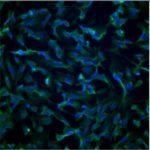Link to Pubmed [PMID] – 9843430
Biochemistry 1998 Nov;37(47):16627-35
Sequence effects on the stability of purine-motif (also called (G, A)-motif) triple helix have been investigated through two symmetry-related systems: one of them had a 5′(GGA)43′ core sequence of triplex-forming oligonucleotides (TFOs), whereas the other one had a reversed 5′(AGG)43′ core sequence. These (G,A)-containing TFOs were prone to self-associate into intermolecular complexes at room temperature. The competition of TFOs’ self-association with triple helix formation was assessed, and minimized. By varying the lengths and the terminal base sequences of TFOs, the following were found that (1) The stability of two triple helices with identical length and base composition but reverse strand orientation may be significantly different (up to a factor of 6). (2) When the 5′(GGA)43′ core sequence was extended at the 3′-end by a G, the 13-nt TFO exhibited 3- and 5-fold higher affinity toward the target double-stranded DNA (dsDNA) than the longer 14-nt and 15-nt TFOs in which one and two A(s) were added at the 3′-end of the 13-nt TFO, respectively. In contrast, when the similar extensions occurred at the 5′-end of the 5′(AGG)43′ core sequence, the length increase provided a higher binding affinity of TFOs toward the target duplex. (3) The nature of the base triplets involved at the ends of triple helices may have great influence on triplex stability. The observed asymmetric sequence effect of the (G,A)-motif triple helix formation is discussed in terms of the binding strength of the first base triplet(s) at the 3′ end which seems to be deeply involved in the nucleation step of triple helix formation and therefore to be a determining factor for triplex stability.

